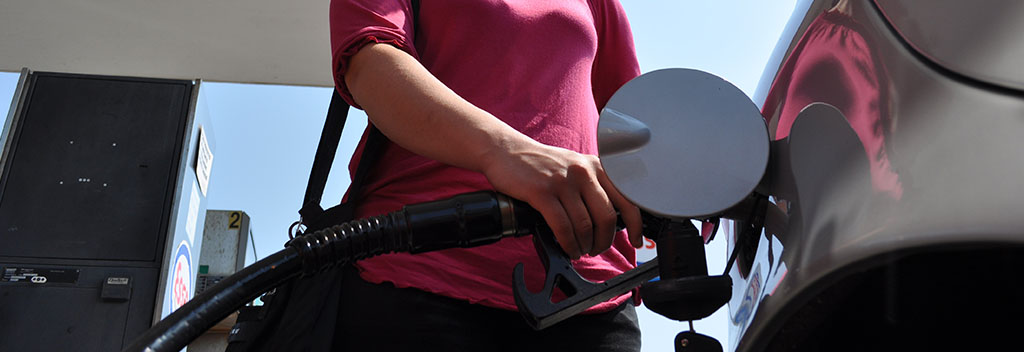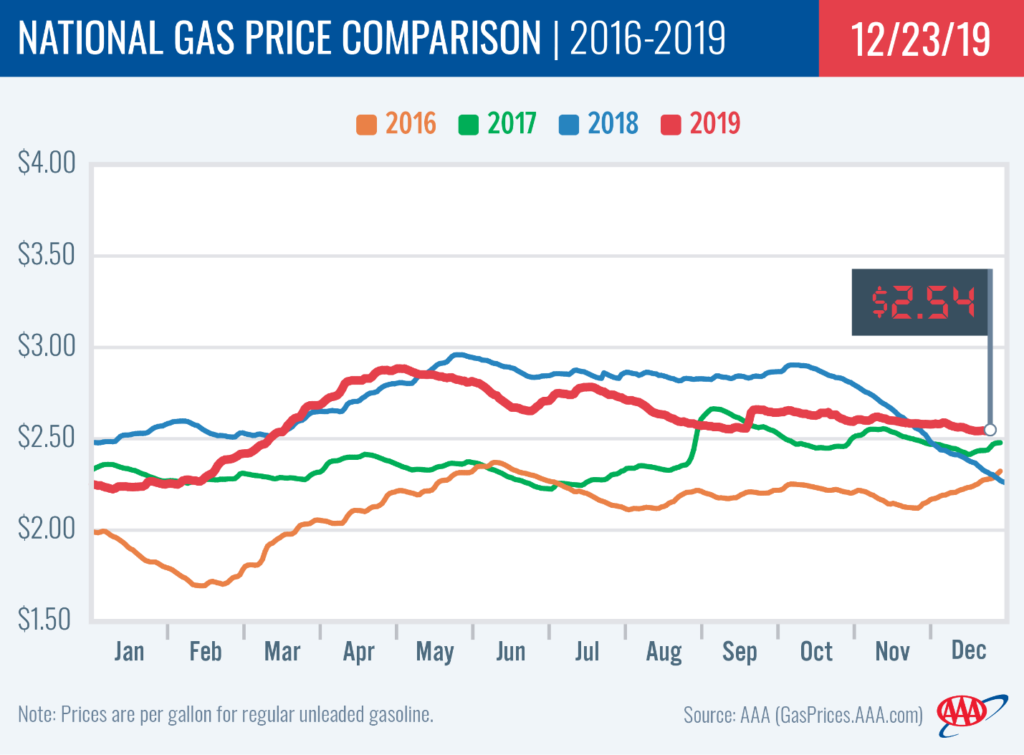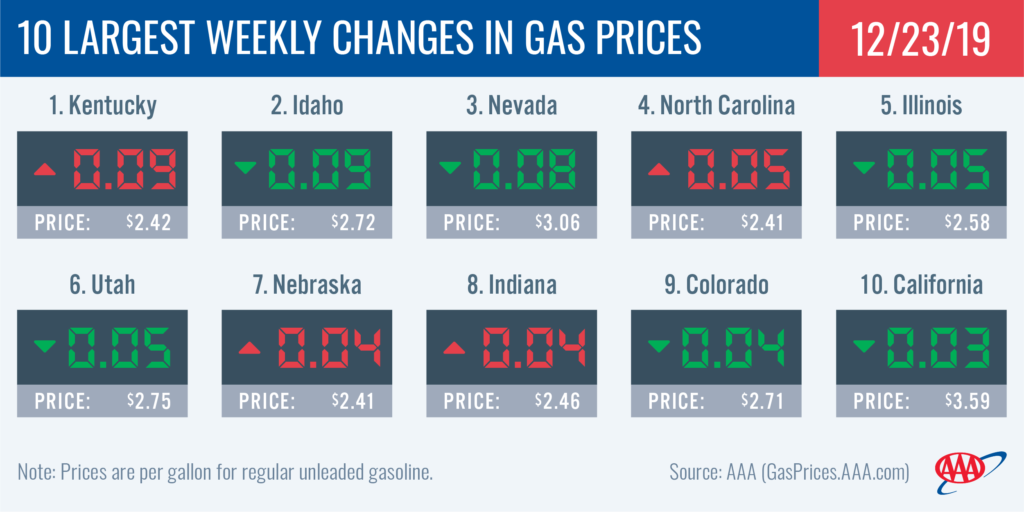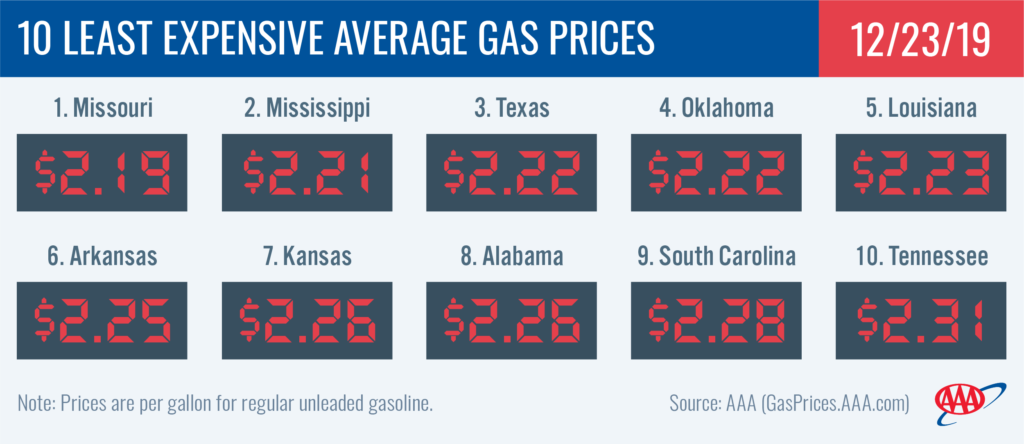
More than 100 million Americans are taking to the roadways to travel for the holidays, but that hasn’t had a large impact on gas prices. At the start of the work week, only about a dozen states are seeing more expensive gas prices with increases of less than a dime.
“AAA forecasts that 104 million Americans will travel by car – the most on record – for a year-end holiday,” said Jeanette Casselano, AAA spokesperson. “The substantial number of motorists has caused some state averages to increase heading into the holiday week, but these jumps aren’t big and won’t last long or linger past the holiday season.”
Today’s national average is $2.54, which is a penny less than last week and a nickel cheaper than last month. While the national gas price average continues to slowly edge cheaper, it is noticeably more expensive as compared to last year’s holidays – by nearly 20 cents. However, this isn’t deterring people from taking their holiday road trips and some states are seeing lower averages than last year.

Quick Stats
• The nation’s top 10 least expensive markets are: Missouri ($2.19), Mississippi ($2.21), Texas ($2.22), Oklahoma ($2.22), Louisiana ($2.23), Arkansas ($2.25), Kansas ($2.26), Alabama ($2.26), South Carolina ($2.28) and Tennessee ($2.31).
• The nation’s top 10 largest weekly changes are: Kentucky (+9 cents), Idaho (-9 cents), Nevada (-8 cents), North Carolina (+5 cents), Illinois (-5 cents), Utah (-5 cents), Nebraska (+4 cents), Indiana (+4 cents), Colorado (-4 cents) and California (-3 cents).

Great Lakes and Central States
Four Great Lakes and Central States land on the top 10 list for largest weekly changes, but for increases and decreases alike: Kentucky (+9 cents), Illinois (-5 cents), Nebraska (+4 cents) and Indiana (+4 cents). The three states with large jumps are exceptions for the region. Filling up continues to be less expensive for the majority of motorists in the region thanks to mostly increasing stock levels since the beginning of November.
While regional prices are mostly cheaper on the week, they range from 18 cents to 47 cents more expensive compared to this time last year. This is likely due to higher winter crude oil prices.
The Energy Information Admiration’s (EIA) latest data shows that stocks built by 1.4 million bbl to total 51.6 million bbl. Currently, regional stocks sit at their highest level since early September, which is helping the majority of the region see cheaper weekly gas prices.
Mid-Atlantic and Northeast
Motorists across the Mid-Atlantic and Northeast states are seeing mostly more expensive gas prices at the start of the holiday week: North Carolina (+5 cents), Maryland (+2 cents), New Jersey (+2 cents), Virginia (+2 cents), Delaware (+2 cents), West Virginia (+2 cents), New York (+1 cent), New Hampshire (+1 cent), Maine (+1 cent) and Connecticut (+1 cent). Increases are incremental and likely due to the substantial amount of holiday motorists – 16 million in the Northeast – expected to travel this week.
In the region, Pennsylvania ($2.75) carries the most expensive state gas price average and lands on the top 10 list of most expensive averages in the country.
EIA data shows that regional gasoline stocks built, but by a marginal 600,000 bbl, to total 62.9 million bbl. In the same timeframe, regional refinery rates increased, though only by 1%. Gas prices are likely to see some fluctuation in the week ahead, but any increases are not expected to be large spikes or to linger for very long.

South and Southeast
Motorists traveling through the South and Southeast during the holidays will find some of the cheapest state gas prices in the country, ranging from $2.19 – $2.41. Drivers in the region are starting the work week with gas prices slightly more or less expensive, but only by a few pennies. Florida (-4 cents) and New Mexico (-3 cents) saw the largest declines while Tennessee (+2 cents) saw the largest increase.
Pump prices saw mostly minimal movement as did gasoline stocks and regional refinery rates. EIA data shows stock levels maintained at a healthy 83.4 million bbl, which includes a marginal 24,000 bbl weekly build. Regional refinery rates dipped slightly, down 2%, to 91%. Despite these small jumps, motorists can expect gas prices to edge cheaper following the holidays.
West Coast
Pump prices in the region continue to decline, with allstates seeing their averages less expensive this winter compared to last year. On the week, Nevada (-8 cents) saw the largest decreases in the region. Hawaii ($3.65) and California ($3.59) remain the most expensive markets in the country. Washington ($3.18), Nevada ($3.06), Oregon ($3.05), Alaska ($3.03) and Arizona ($2.85) follow.
Increased gasoline stocks continue to help put downward pressure on pump prices, even as demand remains robust. According to EIA’s report for the week ending on December 13, total gas stocks in the region grew by approximately 500,000 bbl, bringing the total to 31.63million bbl. The current supply level is 4.08 million bblhigher than last year’s level at this time, which will likely continue to help prices in the region decline throughout the week.
Rockies
Rockies states are seeing some of the largest weekly decreases in the country with Idaho (-9 cents), Utah (-5cents), and Colorado (-4 cents) landing this week’s top 10 list. Pump prices in Montana and Wyoming also edged cheaper during the last seven days.
In the region, state averages range from $2.61 – $2.75, which are very similar to prices last year at this time. This is true for all Rockies states with the exception of Colorado whose average is 36 cents more expensive than this time last year. In Colorado, this year-over-year difference is likely related to more expensive year-end crude oil prices.
The EIA’s latest report shows gasoline stocks higher on the week, jumping to 7.6 million bbl as refinery utilization increased by 4%, to 96%. This winning combination means motorists in the region will see gas prices push even cheaper through the year-end.
Oil Market Dynamics
At the close of Friday’s formal trading session on the NYMEX, WTI decreased by 74 cents to settle at $60.44. Crude prices ended the week up slightly over the previous week amid increased optimism that trade tensions are continuing to decline between the U.S and China — the world’s two largest crude oil consumers. This hope has reduced market concerns that global crude demand will decrease next year, helping to raise price expectations for early 2020.
Crude prices also increased this week after EIA’s recent petroleum status report revealed that total domestic crude stocks decreased by 1.1 million bbl to 446.8 million bbl last week. Total domestic stocks are 5.4 million bbl higher than where they were at this time in 2018.
Motorists can find current gas prices along their route with the free AAA Mobile app for iPhone, iPad and Android. The app can also be used to map a route, find discounts, book a hotel and access AAA roadside assistance. Learn more at AAA.com/mobile.
